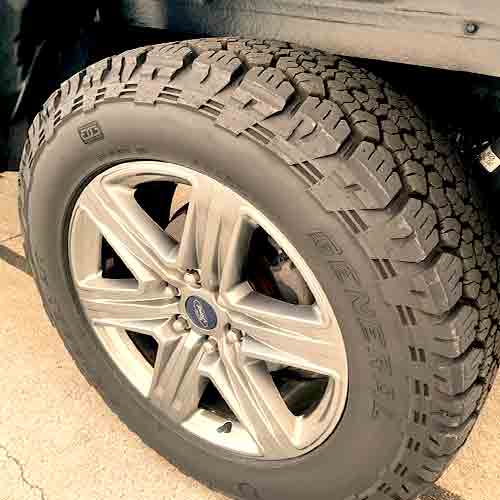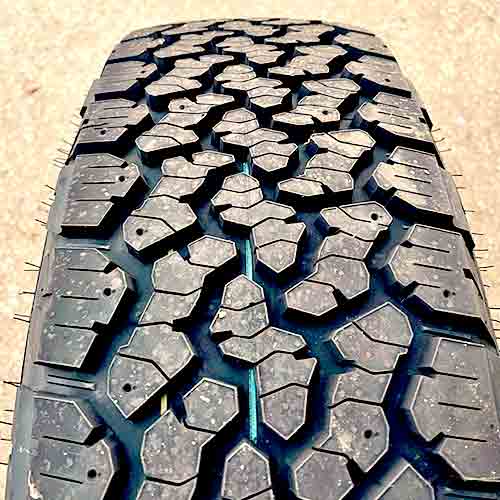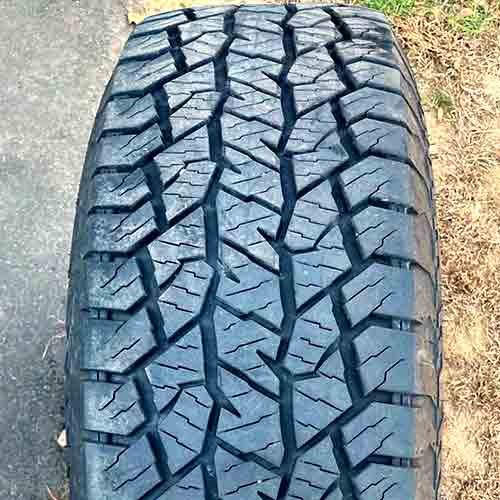Both the General Grabber ATX and the Hankook Dynapro AT2 are all-terrain tires that have caught my attention with their promising tread designs. But which one gets the nod for better on-road manners, and which takes the lead on rugged terrains? Well, lets find out!

Based on my extensive knowledge and experience in tire engineering, the General Grabber ATX comes on top when it comes to wet traction, tread wear, winter performance and grip off-road (on multiple terrains). Whereas the Hankook Dynapro AT2 features superior dry grip, comfort (in terms of on-road noise), and fuel economy.
Table of Contents
Sizes Info
Starting with Hankook Dynapro AT2, this tire has following specs.
- Sizes: 15 to 22 inches
- Speed rating: S and T.
- Load Rating: SL, XL, C, D, E, and F.
- Weight: 29 to 80 lbs
- Tread depth: 12 to 16.4/32″
- Warranty: 60k miles for all
The General Grabber ATX on the other hand has following.
- Sizes: 14 to 20 inches
- Speed rating: Q, R, S and T.
- Load range in SL, XL, C, D and E.
- Tread depth: 14 to 16/32″.
- Weight range: 28 lbs to 75 lbs.
- Warranty: 60k miles.
Tread Features
Let’s start things here with General Grabber A/TX. This tire is very well engineered, as it get to handle all types of terrains with its structure. Let me explain how.

On dry roads, as the tire offers longitudinal alignment of lugs making 4 vertical channels, you get to have ample directional grip.
And as these lugs have an interlocking design you also get biting at multiple sides on off-road terrains, especially on rocks, where the notches on all these lugs along with sipes (that are full depth, capable of opening all the way) chew on the thick surface.
So you can say these sipes have dual functions, i.e. providing wet traction as well as biting abilities on rocks.
On mud, the tire supplies self cleaning grooves as these interlinked channels get connected with the outer circumferential channels, and lateral gaps of shoulders, with bold stone ejectors in them.
These shoulder lugs, furthermore, also offer staggered sides offering mud scoops and their sidewall lugs flex to provide ample traction on sand and other types of soft terrains with lowered air pressure.
On the other side, the Hankook Dynapro AT2 although takes the back seat in terms of aggressiveness, it’s still a pretty capable tire.

The tire’s tread also handles all types of terrains.
The middle most rib is made continuous (lugs attached to each other form underneath), this provides on-road stability, and since all lugs have notches (facing sideways), you also get off-road bite with them as well.
Furthermore, although this central most rib is closed up, the surrounding ones have lugs with wider lateral voids, so the dirt/mud evacuation is not hindered by much.
These tread voids, connect with the outer wider circumferential grooves the tire makes.
Though connecting those are shoulder lugs, which are missing with mud scoops (not staggered). And you also don’t see proper sidewall lugs on this tire either.
So as aggressive the tire is form the middle, it sure lacks a lot on outer edges.
Durability
How durable a tire is depends on its internal construction. And here, although you get a less aggressive design with Hankook AT2, it still offers superior puncture resistance.
It comes with 3 ply polyester casing, with 2 steel belts on top, and 2 nylon cap plies.
Whereas the General Grabber ATX on the other side, only offers 2 ply sidewalls, though it’s thicker lugs there are still helpful, and provide the tire with good enough protection, not too far off form it’s competitor.
Side Note: I talked about this more in Are A/T tires harder to puncture: https://tiredriver.com/are-all-terrain-tires-harder-to-puncture/
Dry Traction
To accurately evaluate the dry performance of these tires, I researched on their directional and lateral grip along with steering response. Let me share my data.
Directional Grip
Directional grip measures the tire’s rolling traction on a straight dry road/pavement. And it depends on the overall tread’s footprint, along with the overall structure.
That’s why the Hankook Dynapro AT2 features shorter braking distances (measure of directional grip), with it’s longitudinally aligned blocks/ribs.
Moreover, as all of it’s blocks are more closed up together, they offer better rubber to road meet up.
The lacking Grabber ATX on the other side, can’t have the same consistency in tread’s exposure with the ground. This is mostly because of the interlocking design causes the grooves to break
Dry Handling
Handling is a major part of overall traction, and it heavily depends on the outer edges of the tire, where the whole weight shifts (when the vehicles turns).
This causes the lugs to bend (in the opposite direction of the turn), resulting in over and under-steering.
That’s why General Grabber ATX with softer compound, and lacking foundational supports (to lugs), gets to offers limited lateral traction, in comparison.
Whereas the Hankook Dynapro AT2 features the opposite; stiffer composition here with shoulder lugs having supporting connectors in between, further adding to the foundation, and providing faster steering response with it.
Wet Traction
The overall wet traction of a tire is a mixture of wet grip and hydroplaning resistance, both basically help in expelling out the water form the grooves.
Wet Grip
On wet pavements, one of the most important tread features include sipes. These are tiny slits in the tread soak up the water, and wipe off the road that way.
But this not the whole story, as Hankook Dynapro AT2 even with a lot of sipes all over the tread, still lacks. So why is that?
Well that’s because it’s sipes lack the ability to flex as much, and create a good enough suction for the water particles coming underneath.
The General Grabber ATX on the other side, is better here, with it’s softer tread composition, which allows it’s full depth sipes to easily contract, and expand, slurping water in with a greater force.
Aquaplaning
Hydro or aquaplaning resistance is crucial in preventing a tire from “floating”. This can happen if water is not able to leave out of the tread in time. And so it also depends on the tire’s rolling speed.
How fast a tire can go over the standing water (called float speeds), tells you about the resistance hydroplaning. So the greater the speed the better.
Out of both tires, the Hankook Dynapro AT2 although offers decent float speeds, but only on straighter paths, as its closed up shoulder lugs don’t allows water to leave out laterally, as easily.
Moreover, it’s continuous running central rib is also not helping here.
The General Grabber ATX on the other side, with its interconnected grooves offers slightly superior results, as on this tire water has multiple pathways to leave out in both lateral and longitudinal angles.
Fuel and Tread Usage
Fuel usage highly depends on the tire’s composition/structure, and weight.
That’s why General Grabber A/TX although offers a lighter structure, it’s balder design still puts more pressure on its lugs, (as the weight gets divided on a smaller tread area), promoting greater fuel consumption.
The Hankook Dynparo AT2 on the other hand, not only comes with more packed up lugs evenly distributing its yet greater weight, it also features a more streamlined design as well, with longitudinally aligned blocks (which roll with lesser resistance).
Though that does not mean it shows superior tread mileage in comparison.
Sure it’s harder compound wears slower, and it’s greater tread depth (on average) takes longer to come down to 2/32″ (legal limit), but it’s rubber does not contain the elasticity needed, as seen on its counterpart.
The Grabber ATX basically has two main components in it’s composition, Kevlar, and aramid nanofiber reinforced polymers, and both of these allow it to not only beat it’s competitor here, but to become the best in the all-terrain category.
That’s why I added it to my list of top A/T tires: https://tiredriver.com/best-all-terrain-tires/
Ride Quality
The two most important elements in determining ride quality are the tire tread noise, and the tire’s capacity to manage road imperfections through its structure and tread composition. Let me examine each of these factors in more detail.
Tread Noise
All tread features, like the sipes, grooves, basically tread voids, have air in them at all times, and as the tire meets the road surface, that air gets expelled out, creating “whistling-like sound”.
And as the tire rolls over, that air then get back in, mostly through the shoulders, and then hit the walls of the tread and create in-groove resonance.
So basically two types of sounds get generated in the tread.
And so since the General Grabber ATX comes with a more open shoulder design, and wider grooves, it gets to be louder as air particles freely move in its tread and hit the walls around with full force.
The Dynapro AT2 on the other side, not only comes with compacted shoulders (killing noise at the source), but you also get to see superior pitch sequencing technology on this tire as well.
I explained this in detail in my post, are all-terrain tires noisy, check here: https://tiredriver.com/are-all-terrain-tires-noisy/
Ride Smoothness
The smoothness of a tire’s ride is influenced by its ability to dampen road roughness, with the tire’s composition being a vital factor.
That’s why the General Grabber ATX coming with a pliable rubber yields better results in the second half of overall comfort performance.
Moreover, aiding to that, the tire also has a dedicated polyamide layer just underneath the tread, which is exactly in charge to settle down the vibrations of the road.
The Dynapro AT2 on the other side although offers a better handling efficacy, with superior stability, it’s still produces a jittery ride nonetheless, with it’s 3 ply polyester casing, and rigid rubber composition on top.
Winter Traction
Winter traction requires a tire’s ability to maintain forward momentum, corner effectively, and quickly respond to braking on various snow surfaces.
And although both of these tires have 3 peak mountain snowflake ratings, the Grabber A/TX still offers better performance, where it’s snow handling leads the category, outperforming nearly all (snow performing) A/T tires.
Though it came in second to Mickey Thompson Baja Boss A/T (review).
On the other side, the Hankook Dynapro AT2 is also pretty great, with it’s sipes better optimized for winter traction (compared to wet grip), though the tire still lacks with it’s stiffer compound which is not as thermal adaptive.
This means, its rubber gets stiffer with freezing temperatures, and its biters aren’t that flexible enough to grab in to the snow particles like before.
Also worth reminding, although off-road tires aren’t so great with ice, the Grabber ATX at-least offers stud-able lugs which allows it to still have a decent traction (capability) on this type of terrain as well.
Off Road Traction
Rugged paths require different skills for each terrain type, that’s why I studied tires in all of these challenging conditions. Let me share it with you.
On Rocks
The perfect tire for rocky terrains should have a soft, flexible tread with lugs that can grip in multiple directions. Moreover, you also need good enough durability (as most of the punctures happen on rocky tracks).
The Hankook Dynapro AT2 although comes with 3 ply sidewalls, and ample biters in the middle, it’s missing sidewall lugs really puts the tire in the back seat here.
The Grabber ATX on the other side does much better here, where it’s although 2 ply, it’s thick enough sidewall lugs protect that area with the same efficacy, besides providing (greater) traction abilities with lowered air pressure.
On Sand
On sand, you need wider tires, which are capable of creating larger contact patch with the surface. This prevents it form digging in to the soft terrain.
And so out of both tires, the General Grabber ATX takes the lead, and with a big margin, I must add.
The tire for one, is lighter in weight, has smoother outer edges, and like mentioned in the rocky terrain section above, comes with bulky sidewall lugs.
It’s lighter structure and less sharper edges prevent the tire form sinking in, and its sidewall lugs supply enhanced tread print and with it floating abilities.
On Mud
On mud, you need a tread with self cleaning grooves, and scooping lugs. And both of these features are provided better on General Grabber ATX.
It presents with a greater voids to tread ratio, and a map of channels allowing mud to leave out through multiple pathways in an easier way.
In comparison, the Dynapro AT2 restricts the mud to leave out sideways, as its not as voided, and only provides longitudinal channels throughout its tread (with central most rib being continuous, and very compacted up shoulder lugs).
Conclusion
The Hankook Dynapro AT2 does better on dry roads, in terms of traction (comes with higher speed ratings), and comfort by offering a much quieter ride.
Moreover the tire is also more fuel efficient despite having a greater weight.
The Grabber ATX on the other side, supply superior, wet traction, tread life, and overall off-road performance.